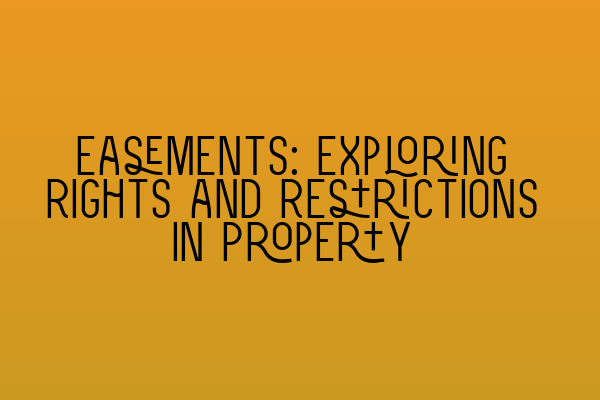Easements: Exploring Rights and Restrictions in Property
When it comes to property law, understanding easements is crucial. Easements are a type of legal right that provides one party with a limited use or enjoyment of another’s property. These rights and restrictions play a significant role in property transactions and can affect both buyers and sellers.
What is an Easement?
An easement is a legal interest in land that allows a party (known as the dominant owner) to use or access another party’s property (known as the servient land) for a specific purpose. This right is typically recorded in the property’s title and is binding on future owners.
Common examples of easements include:
- Right of way: This allows someone to travel across another person’s property.
- Utility easements: These allow utility companies to access a property to maintain or install utilities like water or electricity.
- Drainage easements: These grant the right to drain water through another person’s property.
- Light and air easements: These provide the right to receive natural light or air through a specific opening or window.
It’s important to note that while easements grant certain rights to the dominant owner, they also impose restrictions on the servient land. For example, if a right of way easement exists, the servient owner cannot obstruct or interfere with the dominant owner’s access rights.
Creation and Enforceability
Easements can be created in several ways, including:
- Express grant: When an owner willingly grants an easement to another party and documents it in writing.
- Implication: When an easement is necessary for the reasonable enjoyment of a property.
- Prior use: When an easement arises due to a historical use that was continuous and apparent.
- Prescription: When someone openly and adversely uses another person’s property for a specific period of time.
Once created, easements are generally enforceable, meaning that the dominant owner has the legal right to exercise their easement rights against the servient owner. However, there are certain circumstances in which an easement may be extinguished or terminated, such as through express release or abandonment.
Effect on Property Transactions
Easements can greatly impact property transactions for both buyers and sellers. For buyers, it’s crucial to conduct a thorough property search to identify any existing easements. These easements can affect the buyer’s intended use of the property or even limit future development possibilities. Understanding the nature and extent of easements is essential when making informed decisions.
For sellers, disclosing existing easements to potential buyers is important. Failing to disclose easements can result in legal disputes and potential liability for the seller. It’s always recommended to provide full transparency regarding easements to avoid future complications.
Conclusion
Easements play a vital role in property law, providing both rights and restrictions to property owners. Understanding the creation, enforcement, and impact of easements is essential for anyone involved in property transactions. Whether you’re a buyer, seller, or legal professional, being knowledgeable about easements will help you navigate property transactions with confidence.
If you’re preparing for the SQE exams, check out these related articles:
- SQE 1 Practice Exam Questions
- SQE 1 Practice Mocks FLK1 FLK2
- SQE 2 Preparation Courses
- SQE 1 Preparation Courses
- SRA SQE Exam Dates
